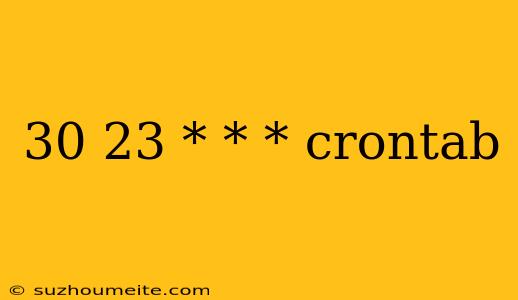Understanding Crontab: 30 23 * * *
Crontab is a powerful tool in Linux systems that allows users to schedule tasks to run at specific times or intervals. In this article, we'll break down the syntax of a crontab entry and explain what each part does, using the example 30 23 * * *.
What is Crontab?
Crontab is a list of commands that are scheduled to run at specific times or intervals. It's a daemon that runs in the background and checks the crontab file for tasks to execute. The crontab file is a plain text file that contains a list of commands, one per line, with each line representing a single task.
The Syntax
The syntax of a crontab entry consists of five fields separated by spaces. Each field represents a specific part of the schedule:
minute hour day month day_of_week
Let's break down each field:
- minute: specifies the minute of the hour when the command should run (0-59)
- hour: specifies the hour of the day when the command should run (0-23)
- day: specifies the day of the month when the command should run (1-31)
- month: specifies the month of the year when the command should run (1-12)
- day_of_week: specifies the day of the week when the command should run (0-6), where 0 = Sunday
The Example: 30 23 * * *
Now, let's examine the example crontab entry: 30 23 * * *.
- minute: 30 - the command will run at 30 minutes past the hour
- hour: 23 - the command will run at 11 PM (23:00)
- day: * - the command will run every day of the month (1-31)
- month: * - the command will run every month of the year (1-12)
- day_of_week: * - the command will run every day of the week (0-6)
What Does it Mean?
So, what does this crontab entry do? It will run the command at 11:30 PM every day, regardless of the day of the month or month of the year.
For example, if you have a command like this in your crontab file:
30 23 * * * /usr/bin/php /path/to/your/script.php
The script /path/to/your/script.php will be executed every day at 11:30 PM.
Conclusion
In this article, we've covered the basics of crontab syntax and explained what each field does. We've also examined a specific example of a crontab entry and what it means. With this knowledge, you can create your own crontab entries to schedule tasks to run at specific times or intervals.
Remember to use the correct syntax and fields to ensure that your tasks are executed correctly. Happy scheduling!
